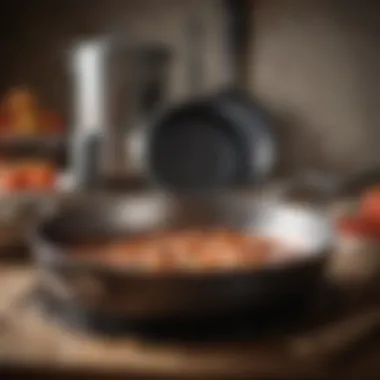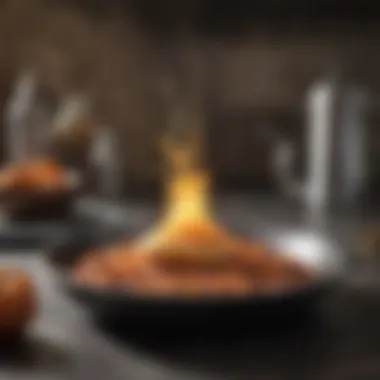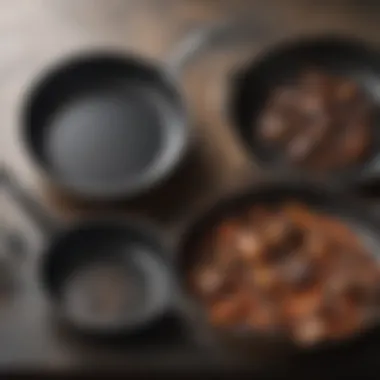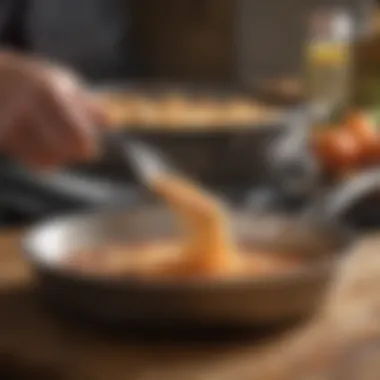Mastering the Art of Cleaning Burnt Pans Efficiently


Intro
Ingredients Breakdown
Primary Ingredients
When tackling burnt pans, several common household ingredients work effectively to lift burnt food residues. These include:
- Baking Soda: Famous for its abrasiveness and gentle chemical reaction with acids.
- Vinegar: Natural acidity can help dissolve tough burns.
- Dish Soap: Standard cleaning agent can offer initial assistance when soaking pans.
- Salt: Acts as a scrubbing agent, enhancing the effects of other cleaners.
Optional Ingredients
Certain optional ingredients may enhance the effectiveness of burnt pan cleaning efforts:
- Lemon Juice: The citric acid in lemons can offer additional cleaning power and a fresh scent.
- Hydrogen Peroxide: Ideal for really tough stains, though only used in diluted formats for safety.
Essential Kitchen Tools
To execute these cleaning methods effectively, a few key tools can enhance the process. These tools include:
- Sponge or Scrub Brush: For applying your cleaning agents and scrubbing
- Bowl or Basin: For soaking the pans; an important step in residue removal.
- Steel Wool: Can be effective for very tough burns but may scratch or damage some surfaces, so use cautiously.
Step-by-Step Preparation
Prepping the Ingredients
Ensure that the pans you wish to clean are available and cool to the touch. Gather the primary and optional ingredients.
Cooking Techniques and Methods
- Soaking: Begin by filling your burnt pan with warm water. Add a sufficient amount of dish soap and allow it to soak for at least 30 minutes; this integrates a preliminary layer of ease for burnt residue.
- Baking Soda Paste: If soaking does not remove the remnants, create a thick paste using baking soda and water. Rub it into the affected areas and leave it for a couple of hours before scrubbing.
- Vinegar Application: For stubborn marks, spritz or pour vinegar on top of any baking soda; the fizzing reaction helps dislodge problem areas.
- Adding Heat: For extreme stubborn burns, placing the pan on low heat for several minutes can assist in loosening the remnants.
Assembly Tips and Presentation
After scrubbing, rinse off residue and finish with a thorough set of warm water rinse to eliminate any cleaner potential left clinging to the pan. Dry immediately to prevent any water spots.
Common Answers to Common Questionss and Troubleshooting
Frequently Asked Questions
- What's the best method for cast iron pans? Always avoid soaking cast iron as it can lead to rust. Natural techniques include coarse salt with oil to clean stubborn sections.
- Can these methods be used on non-stick cookware? While gentler materials like soapy water and baking soda are some safe used, always read your non-stick layer guidelines first.
Common Mistakes to Avoid
Many neglect removing burnt residues promptly before they begin adhering too much. Prolonged intervals are not favorable. Moreover, skipping the soaking step often complicates removal procedures.
Solutions to Potential Problems
If the ingridients do not seem effective, consult experts or user forums like reddit.com for advanced methods among home cooks dealing with similar issues. Therefore invest patience, as not every solution shows immediate results.
Always handle cookware with care while cleaning to maintain its integrity and extend the lifespan of your essential kitchen tools.
Foreword to Burnt Pans
Cleaning burnt pans is an essential task that many home cooks will encounter at some point. It is beneficial to understand how burnt residue affects various cookware. Taking the time to learn effective cleaning methods can extend the life of your valuable pots and pans. Knowing how to treat your cookware properly not only restores its appearance but also ensures that it functions efficiently in your kitchen tasks.
Understanding the Causes of Burnt Pans
Several factors contribute to haivng burnt pans. One primary cause is when cooking over high heat without sufficient oil or liquid. Foods can stick to the surface, resulting in burning. Similarly, items like sugars or sauces may caramalize, making removal difficult, thus preventing proper cooking and cleaning overall. Also, cookware material plays a role.
For instance, non-stick pans may have different burning characteristics compared to stainless steel or cast iron. Recognizing these factors can prevent these kitchen mishaps in the future and will guide the cleaning methods applied later.
Types of Cookware and Their Burnt Residue


Different types of cookware have diverse experiences when it comes to burn residue. Each material will require various cleaning methods.
- Non-Stick Cookware: Superficial burns, mostly observed from sugars or dairy. Cleaning requires gentle methods to avoid further damage.
- Cast Iron: Burnt oils or food remnants. It is important to not soak cast iron appliances since it can damage their season.
- Stainless Steel: Food can adhere, causing heavy residue. Cleaning solutions may vary widely depending on burn severity.
Understanding the specific cookware materials in your kitchen is crucial not only during the cooking process but also when undertaking their cleaning. Prioritizing knowledge can lead to improved overall kitchen maintenance and minimize frustrations with serious stains.
Essential Cleaning Supplies
Cleaning burnt pans requires specific supplies that can effectively break down carbon and tough residues. Understanding the importance of these essentials can make a significant difference in tackling the problem efficiently. Having the right cleaning items at hand not only enhances the cleaning process but also ensures that your pans regain their original condition without damage. It's essential to select suitable substances based on the type of burnt residue from cooking, as some are more effective for certain materials than others.
Common Household Items for Cleaning
Utilizing available household items can be effective and economical for cleaning burnt pans. These staples are often preferable as they are safe and free from harsh chemicals that may damage cookware. Let's explore three commonly used items:
Baking Soda
Baking soda stands out as a versatile cleaning agent. Its gentle abrasive quality and alkaline nature help in breaking down burnt residues. When mixed with water, it forms a paste that can be applied directly to stains. This method of cleaning is particularly effective for stainless steel and cast iron pans. The primary reason baking soda is popular lies in its non-toxicity, making it safe for pots used in food preparation.
Advantages of Baking Soda:
- Non-toxic and safe for food surfaces
- Acts as a mild abrasive
- Cost-effective
Disadvantages of Baking Soda:
- May require some scrubbing for tough spots
Vinegar
Vinegar is another much-utilized household item that serves as a powerful cleaning agent. The acetic acid present in vinegar helps in dissolving mineral deposits, grease, and burnt material. Combining vinegar with baking soda creates a reaction that can lift stubborn stains efficiently. Many choose vinegar for its environmentally friendly profile, offering a sustainable choice for cleaning needs.
Advantages of Vinegar:
- Excellent for removing grease
- Eco-friendly
- Affordable and easy to source
Disadvantages of Vinegar:
- The odor might be off-putting to some
Salt
Salt serves as an effective abrasive cleaner due to its coarse texture. This characteristic allows it to scrub away burnt food without scratching the surface of pots. It is particularly useful when combined with other ingredients like vinegar or lemon juice. Salt also has natural antibacterial properties, which contribute to sanitation while cleaning. Its availability in most kitchens makes it a simple yet effective choice.
Advantages of Salt:
- Easily accessible and inexpensive
- Natural antibacterial qualities
- Good abrasive agent
Disadvantages of Salt:
- May not be effective against very stubborn stains
Commercial Cleaning Products
While household items are beneficial, commercial cleaning products also offer targeted solutions for burnt pan cleaning. Products such as Bar Keepers Friend, Dawn Powerwash, and Easy-Off are specifically formulated to tackle burnt residues. Many users appreciate the convenience and effectiveness of these items, as they often require less effort and time than traditional methods. However, users should always follow the instructions to avoid damaging their cookware. Additionally, be mindful of ingredient lists, as some chemical components may not be suitable for all types of pans.
Using the right combination of household items and possibly commercial cleaners will equip you well in handling burnt pans effectively. Knowing what works best helps familiarize oneself with the materials and conditions, aiding in maintaining durable and functional kitchen tools.
Basic Cleaning Techniques
Cleaning burnt pans can seem daunting, yet adopting proper techniques is essential for restoring the cookware effectively. Understanding basic cleaning techniques not only saves time but often reduces the frustration commonly linked with stubborn stains. Each method described in this section will cover a variety of approaches that cater to different levels of damage, from mild burns to severe charring. It allows cooks of all abilities to choose the best fit for their unique situation and achieve satisfactory results with minimal hassle.
Soaking Method
The soaking method is a fundamental approach for tackling food residues that are baked onto a pan's surface. This technique diminishes the need for excessive scrubbing, thus preserving the surface of the cookware, whether it be stainless steel, cast iron, or non-stick. To utilize this method proficiently:


- Fill the pan with hot water until the burnt sections are submerged.
- Add a few drops of dish soap or a cup of vinegar for additional cleaning power.
- Allow the pan to soak for at least thirty minutes or longer, depending on the severity of the burnt residue.
After soaking, unwanted food particles generally loosen up, making it easier to wipe them away. For deeply burnt pans, it may be beneficial to leave the pan overnight before tackling the stubborn areas.
Scrubbing Techniques
When the soaking method is not effective alone, cleaning with scrubbing techniques is the next step. By applying the right technique, one can successfully remove even the most embedded residues. The key lies in using appropriate tools that won’t damage the pan's surface. Here's how to carry it out:
- Use a soft bristle brush or a no-scratch scrub pad on non-stick cookware.
- For stainless steel or cast iron, a more abrasive tool, like a steel wool pad, can be employed, while still being cautious not to scratch the surface overly.
- Apply a baking soda paste (baking soda mixed with water) onto burnt areas as a gentle abrasive that aids in lifting the residues.
Emphasize short, steady strokes while scrubbing to maintain control, which protects the cookware's integrity.
Boiling Water Method
This technique involves utilizing heat to forcefully combat burnt on materials. It is an effective way to lift stubborn stains and is breathable for most types of cookware. To implement the boiling water method:
- Fill the burnt pan with enough water to cover the stains adequately.
- Add a combination of one to two tablespoons of baking soda for enhanced cleaning properties.
- Bring the water to a rolling boil.
- Allow it to simmer for about 10-15 minutes without any stirring.
After boiling, the heat helps to detach cooked food particles. This may leave the pan easily wipeable with a cloth or sponge afterwards.
Using these basic cleaning techniques reinforces a fundamental understanding of maintaining your pans and enhances the lifespan of your kitchen tools, further alleviating the trivial task cleaning burnt pans.
Natural Cleaning Solutions
Natural cleaning solutions offer an effective and eco-friendly way to clean burnt pans without harsh chemicals. This section is essential because it highlights common household items that can tackle stubborn burnt residue, providing practical alternatives to commercial cleaners. These methods not only contribute to a safer kitchen environment but also align with sustainable living practices.
Using Baking Soda and Water
Baking soda, known for its abrasive properties, acts as a gentle scrub when mixed with water. To utilize this method, follow these steps:
- Sprinkle a generous amount of baking soda onto the burnt areas of the pan.
- Add a few tablespoons of water to create a paste.
- Allow it to sit for at least 15-30 minutes, letting the baking soda work.
- Scrub the pan with a sponge or cloth, focusing on areas with more buildup.
- Rinse thoroughly with warm water.
This method is particularly beneficial because baking soda is non-toxic. It can effectively lift burnt food particles without damaging most cookware surfaces.
Utilizing Vinegar and Baking Soda
Combining vinegar and baking soda can yield stronger results against tougher stains. First, pour about half a cup of vinegar into the pan. Following this, sprinkle a generous amount of baking soda over the vinegar. You will notice fizzing reacts between the two components.
- Allow the fizzing to continue for a few minutes.
- Scrub the pan gently with a non-abrasive cleaning sponge.
- Rinse after all residues are removed.
The acetic acid in vinegar helps break down burnt food on a molecular level. This makes the cleaning surface more manageable and effective compared to using each product alone.
Salt as an Abrasive Cleaner
Salt can be an underestimated but powerful cleaning agent. Its grainy texture provides an abrasive quality that can tackle stubborn burnt bits effectively. Here is how to use salt for cleaning burnt pans:
- Sprinkle a small amount of coarse salt over the burnt areas of the pan.
- Add a bit of water to form a paste if needed.
- Scrub using a sponge or cloth, utilizing the salt as an abrasive exfoliater.
- Rinse your pan well to ensure no salt remains behind.
Salt is inexpensive and easily found in most kitchens. It is ideal for those who prefer to shy away from chemically-loaded cleaning products.
These natural cleaning solutions serve as excellent options for tackling burnt pans, adhering to both environmental and health considerations.
Advanced Techniques for Stubborn Stains
Stubborn stains can be one of the greatest challenges when dealing with burnt pans. Addressing these stains effectively is crucial for restoring your cookware to its former glory. Many times the simple methods might not be enough. Hence, employing advanced techniques becomes necessary.
These methods are beneficial because they utilize specific strategies and tools designed to tackle deep-seated burnt residue that regular cleaning may fail to remove. Understanding when and how to deploy these techniques is vital, as misuse can risk damaging your cookware.
Using a Scraper or Knife
Employing a scraper or knife can be an effective approach for removing stubborn residues that cling to burnt pans. This technique requires careful consideration, as a blunt object might potentially scratch the surface. Look for tools that are specifically made for this task, like plastic scrapers, designed to avoid damaging non-stick coatings.
- Select the Right Tool: Use a plastic or wooden scraper to avoid scratches. Metal scrapers may cause long-term damage to your pans.
- Methodology: Angle the scraper against the pan's surface. Slide the tool under the burnt food, applying steady pressure. This can loosen burnt pieces.
- Additional Help: If necessary, dampen the area with water or vinegar first to soften the residues further.


Utilizing a scraper is a tactful choice when faced with heavily burnt spots. However, your awareness of material compatibility with your utensils is key to maintaining pan integrity.
The Power of a Dishwasher
Sometimes the best solution comes from technology rather than manual techniques. Many people often overlook the dishwasher as a viable solution for burnt cookware.
Preventative Measures
In any kitchen, the challenge of burnt pans often arises unexpectedly. However, by prioritizing preventative measures, home cooks can significantly reduce the risk of ending up with corrosion and residues that are difficult to remove. Understanding these practices is essential, as they provide both immediate and long-term benefits to cookware maintenance, ensuring they remain in optimal condition for longer periods.
Proper Cooking Techniques
The way you cook plays a crucial role in preventing burnt pans. For example, selecting appropriate heat levels is key. Higher temperatures may speed up cooking but also increases the risk of food burning. Thus, adjusting burner sizes based on cookware size can make a big difference. Additionally, stirring foods regularly and keeping an eye on timing also prevents residues from forming.
- Use even heat: Instead of high heat, which is often the cause of scorching, moderate heat allows for even cooking. This factor is hugely significant with delicate dishes like sauces.
- Watch your food: Staying attentive while cooking creates a better outcome. Lifting the lid occasionally to check on progress prevents overcooking.
While following so-called 'proper cooking techniques,' always remember to use fats or oils. These materials provide a protective layer that guards against food from sticking and ultimately burning. Methods that employ pan coating or oiling pans can also ensure that meals release from cookware smoothly.
Using the Right Utensils
Another layer of defence lies in choosing your utensils carefully. Sturdy wooden or silicone spatulas tend not to scratch your cookware’s surface. Thus preventing scratches minimizes the risks associated with certain cleaner applications later.
- Avoid metal utensils: Using metal tools increases the likelihood of marking or damaging your non-stick products. This damage can lead to precisely the type of burning we seek to avoid.
- Thicker materials yield better results: Lightweight or flimsy utensils could lead to scraped surfaces. The heavier, more robust utensils allow for controlled operation of food, less likely to cause trouble.
Ultimately, convenience needs to match compatibility. Prioritising utensils suitable for your pans creates a balanced environment that supports better cooking interactions, reduces the chances of burn marks appearing right at the first point.
Research consistently shows that a bright finish on pans can contribute to food releases.
By integrating both cooking techniques and appropriate utensils into daily meal preparation, cooks can set a worthwhile foundation. Preventative behaviours ease the process often associated with cleaning burnt cookware later on. Many advantages accompany these measures, ultimately saving time, effort, and enhancing overall cooking satisfaction.
Recycling Burnt Cookware
Recycling burnt cookware serves as an important aspect of sustainable kitchen practices. It promotes environmental benefits while reducing waste. Instead of tossing out burnt cookware, home cooks may effectively reclaim items and minimize their overall kitchen footprint. This section explores the principles for determining when cookware should be replaced and the creative ways to repurpose it.
Understanding When to Replace
Recognizing when to part ways with your cookware can be nuanced. Some signs clearly point toward replacement. For example, deep scoring or warping can affect cooking performance. Similarly, if a pan is cracked or shows signs of peeling, it’s prudent to consider replacing it.
Even if a pan is still functional, burnt remnants stuck on its surface may indicate the need for replacement. Here are some considerations:
- Safety Risks: Teflon coatings that are damaged may pose health risks.
- Performance Impact: Burn marks often reduce the efficiency of heat distribution.
- Cosmetic Appeal: Aesthetics may also play a role—for many, a burnt pot or pan is hard to appreciate.
These indicators are crucial when pondering whether to keep a piece or invest in new cookware.
Creative Repurposing Ideas
Before discarding burnt cookware, consider how to give these items a new life. Creative repurposing opens avenues for imaginative uses that can serve both practical and decorative purposes. Here are ideas for repurposing:
- Planters: Old pans can transform into striking planters, held by herbaceous creations and flowers. Consider drilling holes for drainage if required.
- Artwork Display: Creating unique art pieces from distressed cookware can add eclectic charm. Hang pots creatively as wall art or use tarnished lids as decorative covers.
- Garden Tools: Converted utensils can serve as unconventional but imaginative gardening tools.
- Storage Solutions: Stack odd pans to create an artistic display of kitchen organization. Use cookware creatively for storing pantry items like dried spices or pasta.
Recycling and repurposing not only conserve resources but also invite creativity into our kitchen practices.
Participating in this cycle of reusing and repurposing does not require extensive craftsmanship. The joy of taking something that seems damaged and turning it into functional décor or tools provides not only satisfaction but downplays the guilt associated with spoilage and waste infusion. Engagement in this practice contributes heavily towards resource conservation and personal creativity.
The End
Cleaning burnt pans can often seem like an insurmountable task for many home cooks. However, this guide offers approaches that are practical and accessible. It highlights multiple effective techniques using common household products and advanced methods tailored for stubborn stains, ensuring the restoration of your cookware without unnecessary frustration.
Summarizing Effective Techniques
Key techniques discussed in this article range from the simple to the complex, catering to different levels of soiling and types of pots and pans. For everyday burnt residues, soaking and scrubbing with basic ingredients such as baking soda, vinegar, and salt yield satisfaction, often revitalizing your cookware with minimal effort.
In cases of more entrenched scorch marks, methods applying boiling water and scraping techniques may become necessary. Utilizing your dishwasher serves as an alternative way to manage grease and other residues for certain types of cookware. The synergy of various techniques ensures all users - from novices to seasoned chefs - have pathways to recover their pots and pans.
Encouragement for Home Cooks
Even well-prepared meals can sometimes conclude with burnt cookware. Recognizing that such accidents are general illustrates that there's no reason for concern on the part of home chefs; mistakes happen. By acquiring skills to manage burnt pans, you gradually fortify your abilities in the kitchen, comprising a valuable part of your culinary repertoire.
It is essential to appreciate that successful cleaning extends beyond merely achieving clean pans; it fosters a greater understanding of cooking principles and utensil care. Each time destruction comes to your pan, consider it a learning experience – honing your cooking finesse and resourcefulness.
Burnt pans are not the end of a good cooking experience but rather an opportunity to reinforce your knowledge and skill. Embrace the challenges and reclaim harmony between your culinary creativity and your cherished cookware.







